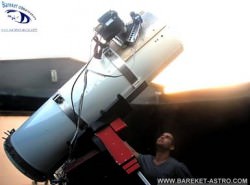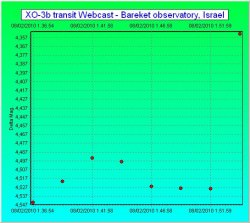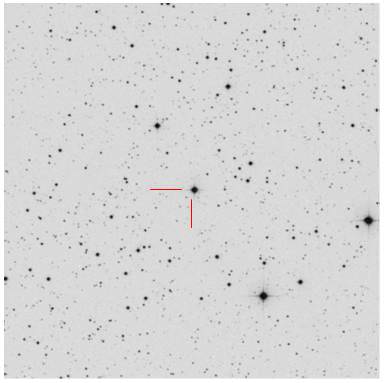[/caption]Almost everyone the world over recognizes the letters X and O to represent a kiss and a hug, but this time the XO stands for Extrasolar Planet XO-3b. If you’d like an extra special “kiss and hug” for Valentine’s Day, then why not visit with Baraket Observatory on Februrary 13th as they present their live, on-line AstroCast of XO-3b transiting its parent star! This is definitely an event you won’t want to miss, so step inside for more information…
 On February 13, 2010, Baraket Observatory will webcast (weather permitting) the transit of an extra solar planet named “XO-3b”. The event will be observed by using a highly sophisticated robotic telescope and a sensitive cooled CCD camera. The observatory will transfer live images of the transit as they’re being captured by the Bareket Internet EDU scope, while plotting its light curve through the site as the transit progress. This truly amazing process will give students and the general pubic a unique in side view to behind the observatory scenes, while presenting to the viewers how science is being done – all in real time. The event will be about 2 hours in duration, scheduled to take place at 19:00 UTC.
On February 13, 2010, Baraket Observatory will webcast (weather permitting) the transit of an extra solar planet named “XO-3b”. The event will be observed by using a highly sophisticated robotic telescope and a sensitive cooled CCD camera. The observatory will transfer live images of the transit as they’re being captured by the Bareket Internet EDU scope, while plotting its light curve through the site as the transit progress. This truly amazing process will give students and the general pubic a unique in side view to behind the observatory scenes, while presenting to the viewers how science is being done – all in real time. The event will be about 2 hours in duration, scheduled to take place at 19:00 UTC.
Live Astro-cast of the ExtraSolar Planet XO-3b Transit
Live Astro-cast of the ExtraSolar Planet XO-3b Transit (European Server)
 The American Association of Variable Star Observers (AAVSO) is collaborating with Bareket Observatory on variable-object studies, of which transiting exoplanets are a key element. The AAVSO has calibrated nearby stars in each of the known transiting exoplanet systems to act as local standards against which you can compare the host star for variability. The AAVSO is also working with the XO project team to study other variable stars that they have discovered during their exoplanet survey. Exoplanet transits are hard to detect, since the dip is only one percent or so in brightness, but with care, any amateur observer with a CCD camera can watch the transit of a planet around another star. A transit means the extra solar planet acts very similar to Venus, in our own solar system, when it passed in front of our Sun (in a direct geometrical line between the sun and the Earth), featuring a “mini eclipse”. While Venus can be easily observed against the solar disc, the extended XO-3b planet only presented as a dim singular dot in the sky. While it’s total brightness only slightly vary during the extra solar planet transit, for a relatively short period of time. The drop in the brightness is proportional to the planet’s surface. Usually within a 1% for a gaseous giant (Such as Jupiter) and as low as 0.01% for an Earth–sized planet. Searching for extra solar planets by detecting their transit is well within the possibilities of many today’s Earth based observatories and now watching a transit electronically is like a dream come true!
The American Association of Variable Star Observers (AAVSO) is collaborating with Bareket Observatory on variable-object studies, of which transiting exoplanets are a key element. The AAVSO has calibrated nearby stars in each of the known transiting exoplanet systems to act as local standards against which you can compare the host star for variability. The AAVSO is also working with the XO project team to study other variable stars that they have discovered during their exoplanet survey. Exoplanet transits are hard to detect, since the dip is only one percent or so in brightness, but with care, any amateur observer with a CCD camera can watch the transit of a planet around another star. A transit means the extra solar planet acts very similar to Venus, in our own solar system, when it passed in front of our Sun (in a direct geometrical line between the sun and the Earth), featuring a “mini eclipse”. While Venus can be easily observed against the solar disc, the extended XO-3b planet only presented as a dim singular dot in the sky. While it’s total brightness only slightly vary during the extra solar planet transit, for a relatively short period of time. The drop in the brightness is proportional to the planet’s surface. Usually within a 1% for a gaseous giant (Such as Jupiter) and as low as 0.01% for an Earth–sized planet. Searching for extra solar planets by detecting their transit is well within the possibilities of many today’s Earth based observatories and now watching a transit electronically is like a dream come true!
Flowers and candy for Valentine’s Day? Sure, that’s nice… But if you want to win an astronomer’s heart, give ’em a big XO!
This project is a part of the Bareket observatory Live-@stro outreach programs.

